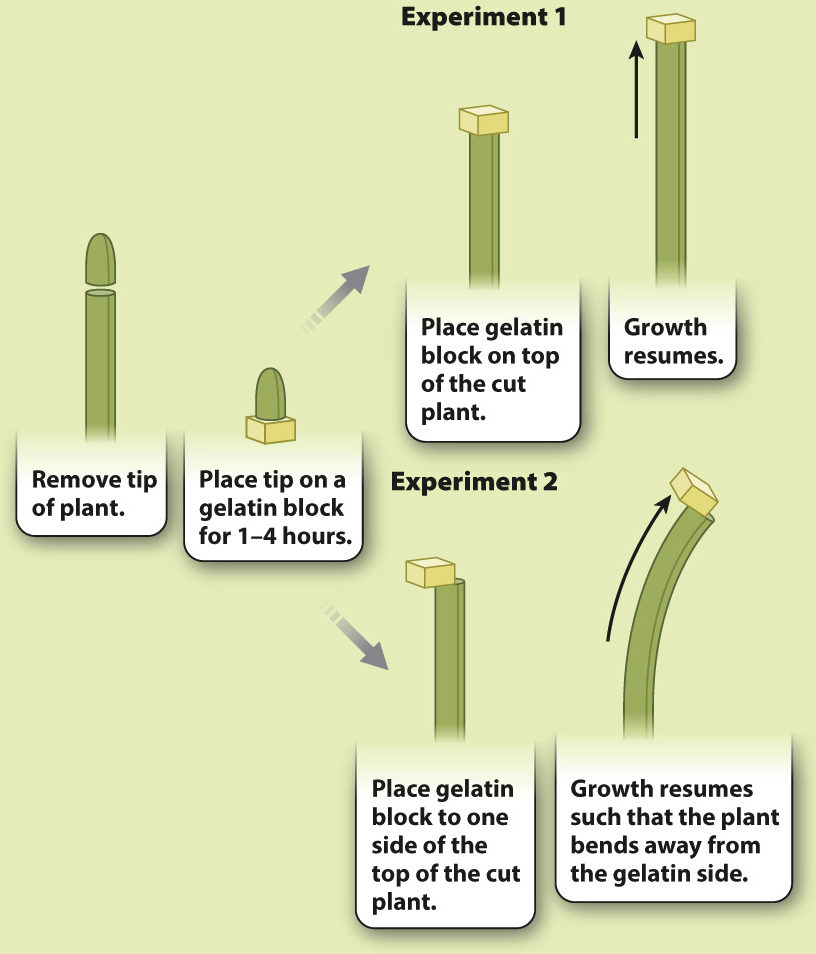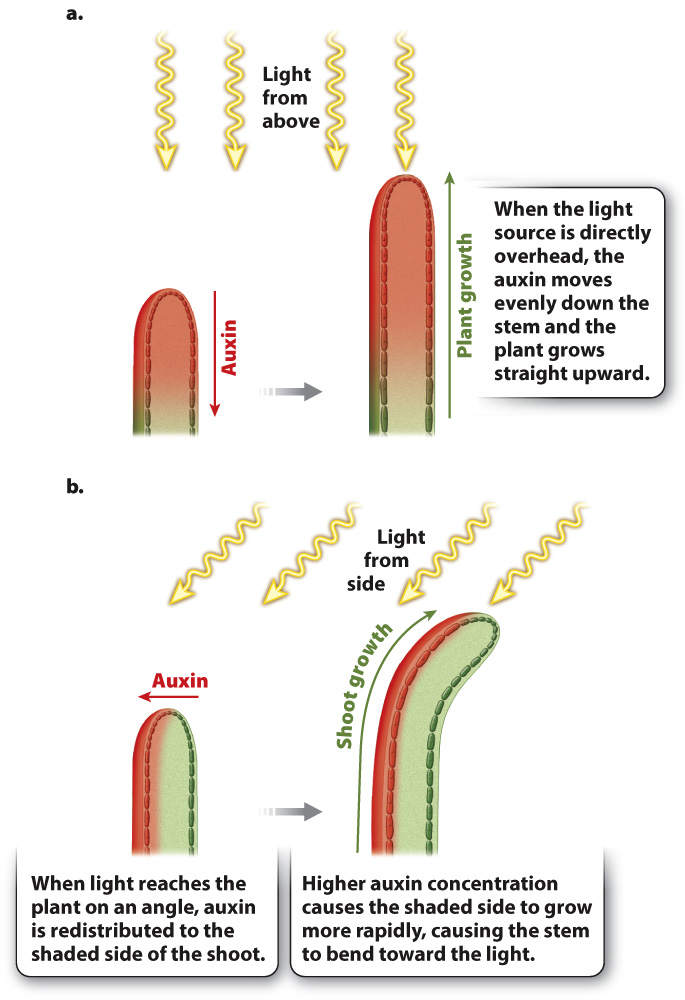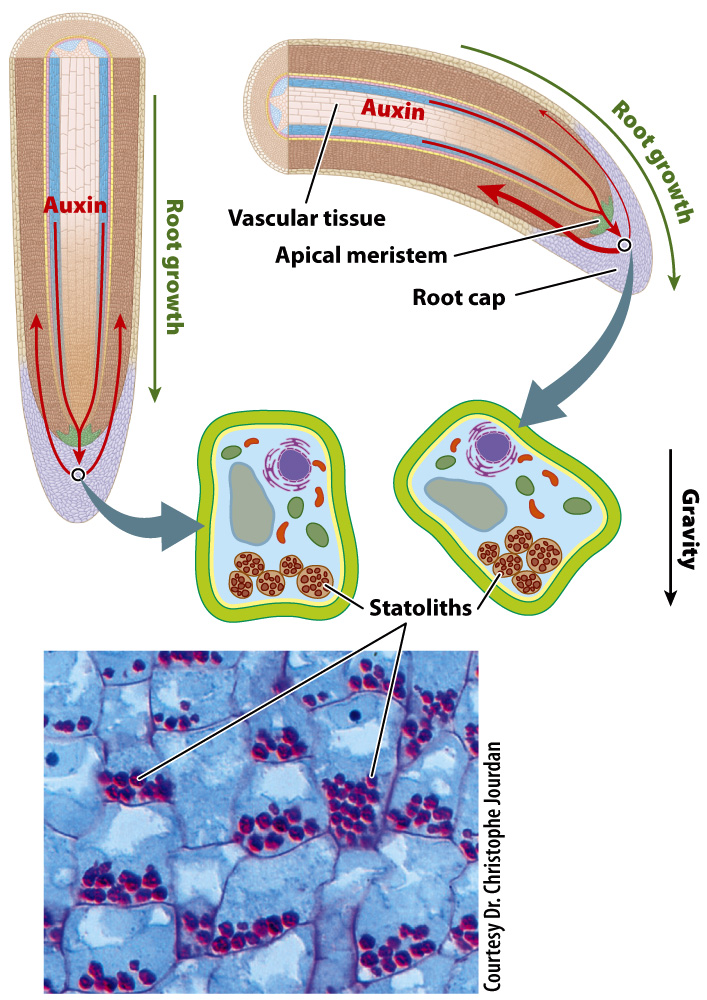Plants orient the growth of their stems and roots by light and gravity.
If you lay a plant on its side, its stems will turn upward and its roots will bend downward. Similarly, if you place a houseplant near a window, the shoot will grow toward the light. Tropism is the bending or turning of an organism in response to an external signal such as light or gravity. Plant stems are positively phototropic, meaning they bend toward the light. Plant stems are also negatively gravitropic, meaning they grow upward against the force of gravity. In contrast, plant roots grow down and away from the light. Thus, roots are positively gravitropic and negatively phototropic.
Observing that grass seedlings bend toward light, Charles Darwin and his son Francis conducted experiments to determine what part of the plant detects light. When they covered just the tip of the young plants, the plants no longer grew toward the light, but when they buried them in fine black sand so that only their tips were exposed, they did. This experiment established the shoot tip as the site where the light is perceived but left open the question of what kind of signal caused the plants to bend (Fig. 31.19).
HOW DO WE KNOW?
FIG. 31.19
How do plants grow toward light?
BACKGROUND In 1926, Frits Went, a Dutch graduate student, followed up on the experiments of Charles and Francis Darwin. In particular, Went sought to understand how the perception of light by the tip of the plant led to a growth response farther down the stem. He reasoned that if the signal from the shoot tip was a chemical, he could isolate it by cutting the tip off of a growing plant and putting it on a block of gelatin. The gelatin would act like a trap, capturing any chemical that moved out of the shoot tip.
HYPOTHESIS A chemical signal links the perception of light by the shoot tip with the growth of the stem toward light.
EXPERIMENT Went cut off the tips of young oat plants (Avena sativa) and placed them on gelatin blocks for periods of 1 to 4 hours. Removing the tip of the plant caused the plants to stop elongating. When the gelatin block was placed on top of the cut plant (Experiment 1), growth resumed. This experiment demonstrated that a growth-

Interestingly, Went found that if the block of gelatin was not centered on the tip but instead was a bit off center, the plant bent away from the side of the gelatin block (Experiment 2). In this case, the side of the plant exposed to the gelatin block grew faster, causing bending, because it received more of the chemical signal.
CONCLUSION A signal is produced in the tip of the plant and travels downward through the stem, toward the roots. This signal stimulates growth. Light causes the signal to move to the opposite side, stimulating growth on that side, which in turn causes the plant to bend toward the light. This signal is now known to be a plant hormone, called auxin from the Latin word augere, “to increase.”
FOLLOW-
SOURCES Darwin, C., and F. Darwin. 1880. The Power of Movement in Plants. London: John Murray; Went, F. W. 1926. “On Growth-
Photoreceptors allow plants to detect and respond to light. If a plant is exposed to light from only one side, only the photoreceptors on the illuminated side are activated. Phototropism in plants involves a photoreceptor that absorbs blue wavelengths of light. The absorption of blue light by the photoreceptor is thought to trigger a change in the placement of PIN proteins so that auxin is transported to the shaded side of the stem. As a result, concentrations of auxin are higher on the shaded side and lower on the illuminated side. Because auxin stimulates cell expansion in stems, the shoot grows faster on the shaded side than it does on the illuminated side, causing the plant to bend toward the light (Fig. 31.20).

Phototropism in roots is similar, in that illuminating a root from the side causes auxin to be redistributed toward the shaded side. In this case, auxin is transported to the shaded side within the root cap, and then moves upward in the outermost layer of cells into the zone of cell elongation. However, higher auxin concentrations decrease the rate of cell elongation in roots, causing roots to bend away from light. The reason that auxin redistribution leads to such a different response in roots compared with shoots is that roots and stems differ in their sensitivity to auxin and that in roots high concentrations of auxin trigger the production of the hormone ethylene, which reduces cell elongation.
A similar mechanism orients plants with respect to gravity. Moving a plant to a horizontal position results in the transport of auxin to the lower side. The accumulation of auxin on the lower surface causes stems to bend up and roots to turn down. How is the plant able to detect which way is up and which way is down? Recall that plants store carbohydrates as starch. Starch is a large molecule that has a density greater than water. Starch-
